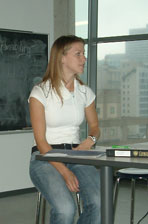Making a sustainable difference

Alea Morren leads an information session on the Sustainable Ambassadors program held in the EV Building last month. Morren is responsible for the program which encourages staff and faculty to adopt greener workplace practices.
Photo by Julie Laurin
Movies like Al Gore’s An Inconvenient Truth and gloomy predictions about global warming and depleting natural resources can be overwhelming.
“I want to address that attitude of ‘I can’t do anything, the problem is too big, why should I care?’” Alea Morren said.
She is developing the Sustainability Ambassadors program through Sustainable Concordia to help staff and faculty identify improvements they can make in the workplace.
“It’s in everyone’s interest to cut costs and waste,” she said.
An informal group of interested staff has been meeting with Sustainable Concordia coordinator Melissa Garcia Lamarca since last year. Morren, who was a volunteer with the group for two years, was hired to develop the program in June.
“It’s not reinventing the wheel. It’s pulling in resources that exist and integrating them into the workplace,” she said.
Owen Moran, a health educator at Health Services, has been involved since those initial meetings. “This fits in with my personal philosophy, I don’t have a car and I bike to work. I have a vermi-composter at home and I seal my windows with plastic. It made sense to translate that to the work environment.”
Moran has been identifying problems and introducing changes. “We used to produce patient charts that only used one side of the page. I asked why we did that, and together we were able to brainstorm a way to produce double-sided charts.” Even with a few glitches, three months later, the reduction in paper use is appreciable.
In a similar vein, Moran realized that by putting recycling boxes in the Health Services waiting room meant that the pop bottles and cans that were piling up would no longer become landfill. “These changes happened slowly, but they do happen. I don’t approach people with a wagging finger,” Moran said.
Moran was one of a handful of staff who worked with Morren over the summer to develop the ambassador program Tool Belt. The program’s main component is a binder which provides interested staff members with a checklist to assess the practices and materials currently used in their offices, and to suggest alternatives.
The binder has a series of sections ranging from consumption of energy, materials and water to planning sustainable events. Each section mixes facts with tips on how to institute change, like encouraging double-sided copying, turning off lights or promoting more active recycling. “The materials also raise awareness, and introduce new ways of working” Morren said.
Morren recognizes that time is also at a premium. Staff who feel overloaded but are interested can simply fill out the checklist and meet with Morren over lunch. “Once we identify what can be done, I can help.”
The Ambassador program had its official launch in two meetings on both campuses in September. Two-dozen people attended, bringing to 10 the number of departments with staff who want to be involved.
“We want to challenge the university to have 25 to 30 ambassadors from different departments by the end of this year, and to increase that number every year,” Morren said.
Neale McDavitt, from IITS, went to the meeting because he had begun to consider the impact of his own wasteful habits. Interested in instituting recycling among his colleagues, he was surprised to find three other people from his department had shown up with similar ideas. The four of them have met and divided up the tasks they saw as priorities.
“The important thing is to provide the infrastructure, I think people want to do things sustainably, but they don’t know how.”
The overall impact of the program will be difficult to measure. Heating and lighting costs are centralized, making it hard to determine the impact of turning off unused equipment and lights on just one floor. However, Morren said that they will keep track of changes made in each department.